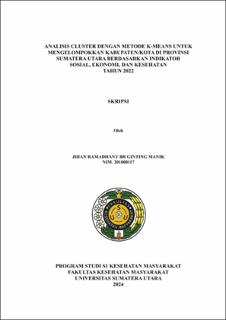| dc.description.abstract | The success of development in each region, the government needs to record and
classify which regions still need treatment in the development process. This is
viewed from social, economic and health indicators which are in line with the
Human Development Index. The science that can be implemented in grouping is
cluster analysis. This research will discuss Cluster Analysis of the Human
Development Index in North Sumatra Province. Cluster analysis is a technique for
grouping objects based on similar characteristics. The aim of this research is to
group the HDI in North Sumatra Province based on 9 variables, namely life
expectancy (X1), expected length of school (X2), average length of school (X3), real
expenditure per capita (X4), level of complaints. Health (X5), infant mortality rate
(X6), open unemployment rate (X7), number of poor people (X8), and population
(X9). The cluster analysis method used in this research is K-Means. From the
analysis results it was found that the grouping of 33 districts/cities in North Sumatra
Province could form 4 clusters, namely cluster 1 was dominant over variable X6
which had a total of 5 districts/cities in the low category, cluster 2 was dominant
over variable 11 districts/cities in the high category, cluster 3 is dominant over
variables X2, members are 15 districts/cities in the medium category. The variables
that provide the biggest differences are life expectancy (X1), average years of
schooling (X3), real expenditure per capita (X4), infant mortality rate (X6), and
population (X9). Regional governments are advised to create programs that are
relevant to the problems of each region based on the supporting determinants of
each region. | en_US |


